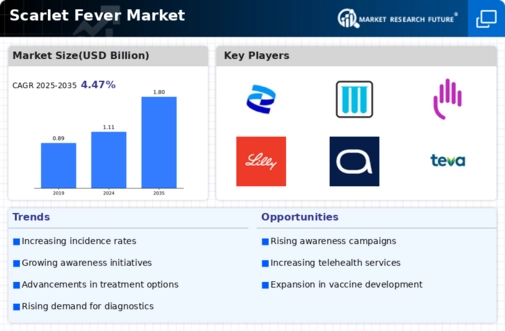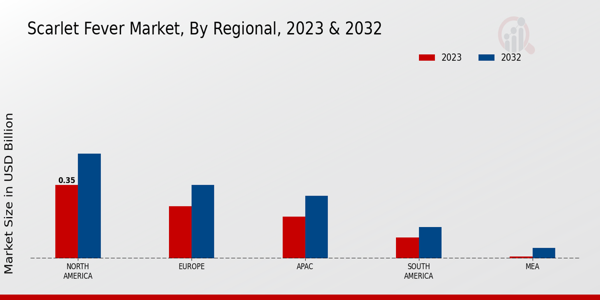Increased Awareness and Education
The Global Scarlet Fever Market Industry is benefiting from heightened awareness and educational initiatives aimed at both healthcare professionals and the general public. Campaigns focused on the symptoms, transmission, and prevention of scarlet fever are crucial in reducing the incidence of the disease. As communities become more informed, early detection and treatment are likely to improve, which could lead to a decrease in severe cases. This growing awareness is expected to drive demand for medical consultations and treatments, thereby positively impacting market growth. Educational programs by health organizations are essential in fostering a proactive approach to managing scarlet fever.
Rising Incidence of Scarlet Fever
The Global Scarlet Fever Market Industry is experiencing growth due to an increase in reported cases of scarlet fever, particularly among children. In recent years, health authorities have noted a resurgence of this bacterial infection, which is primarily caused by Group A Streptococcus. This rise in incidence is prompting healthcare systems to allocate more resources towards prevention and treatment, thereby driving market expansion. The World Health Organization indicates that the disease remains prevalent in various regions, necessitating improved diagnostic and therapeutic measures. As awareness increases, the demand for effective treatments and preventive strategies is likely to grow, contributing to the market's upward trajectory.
Government Initiatives and Funding
Government initiatives aimed at controlling infectious diseases are playing a pivotal role in shaping the Global Scarlet Fever Market Industry. Increased funding for public health campaigns, research, and healthcare infrastructure is likely to enhance the capacity to manage scarlet fever outbreaks effectively. Governments are focusing on improving access to healthcare services, which may lead to earlier diagnosis and treatment of the disease. As public health policies evolve, the market could witness a surge in demand for effective treatments and preventive measures. The commitment of governments to combat infectious diseases is expected to create a favorable environment for market growth.
Market Trends and Data Visualization
Advancements in Diagnostic Techniques
Technological innovations in diagnostic methods are significantly influencing the Global Scarlet Fever Market Industry. Enhanced testing capabilities, such as rapid antigen detection tests and molecular diagnostics, facilitate quicker and more accurate identification of scarlet fever. These advancements not only improve patient outcomes but also enable healthcare providers to implement timely interventions. As a result, the market is likely to see an increase in the utilization of these diagnostic tools. The integration of technology in healthcare is expected to enhance the overall management of scarlet fever, thereby fostering growth in the industry. The ongoing development of novel diagnostic solutions may further bolster market dynamics.
Projected Market Growth and Economic Factors
The Global Scarlet Fever Market Industry is projected to reach 1.11 USD Billion in 2024 and is anticipated to grow to 1.8 USD Billion by 2035, reflecting a compound annual growth rate (CAGR) of 4.47% from 2025 to 2035. This growth can be attributed to various factors, including the rising incidence of scarlet fever and advancements in treatment options. As the market expands, stakeholders are likely to invest in research and development to enhance therapeutic solutions. The economic factors influencing healthcare spending and the prioritization of infectious disease management are expected to further drive market dynamics, creating opportunities for growth.













